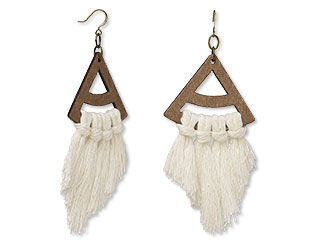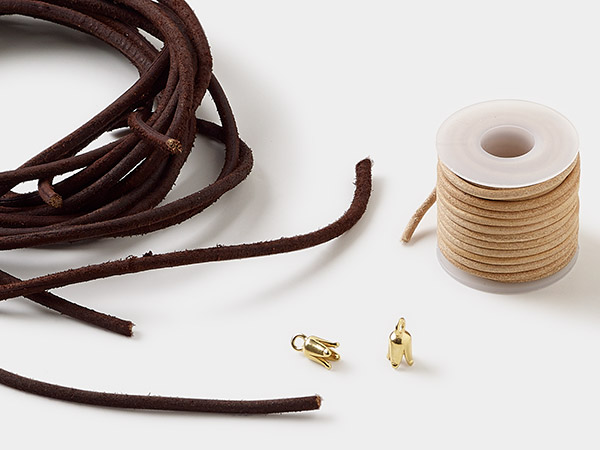Natural Beauty Designing with Sustainable & Ethically Sourced Organic Materials
Eco-conscious creation is not a new concept by any means, but as the consumers' education on climate change continues so does the need for artisans and business owners to be transparent--especially when it comes to organic materials. Shell, leather, nuts and wood products come from living things. Knowing their origins and cultivation techniques will allow you to confidently assure your customers that you've considered every detail of your design and greatly increase the marketability of your piece. Consumers want to speak with their dollar and make their purchases. Luckily, Fire Mountain Gems offers a wide variety of sustainable and ethically sourced organic materials options to help you and your customers shop with assurance.
Waste Not, Want Not
Rest assured that all our animal products, be it bone, leather, feathers or shells, are collected only as by-products of other industries. It's for this reason why certain products, such as the saddle feathers of birds, will never be carried by Fire Mountain Gems. We also try to take into consideration religious observances when it comes to our animal products. For example, many of our bone and horn products come from India where religious observances require that products be harvested only from an animal that has died of natural causes.
As one of the most flexible flat materials available, leather's fibrous structure can be molded, stretched, dyed and joined with metal fasteners for versatile design possibilities. Our leather products are sourced from animals that were legally used for meat. So, whether you are designing for affluent aesthetics or rough and rugged everyday wear, our ethically sourced leather inventory has you covered. Utilize scraps in assemblage pieces to reduce waste and create something unexpected.
Shells like mother-of-pearl, mussel and more possess an organic allure and cost-conscious versatility, making them an exceptional complement to all types of jewelry designs. Create popular tree of life pendants, wire-wrapped drops, or weave around charms for colorful, unique looks. Many of our shell items were either found along the beach or collected from mollusks used for food.
Cultivated and Plentiful
Wood is one of the oldest adornment materials used due to its availability and canvas for carving. The use of wood has come a long way and can now be processed, treated, dyed, carved and polished into items such as beads, pendants and jewelry displays. Wood beads come in a vast array of shapes and sizes like oval, tubular, round and flat shapes. Additionally, designing with wood allows for resilient, long-lasting style and is a natural fit for nature-inspired projects and earthy designs.
A majority of our wood materials are cultivated from fast-growing trees such as Taiwanese Cheesewood, Korean boxwood, Indian rosewood and bamboo. In addition, many of these types of wood are raised in plantation crops, aiding in preserving the rainforests. Renewable products such as wood prevent poverty in substandard farmlands by providing a means of income for those who reside in remote areas.
Create colorful, lightweight designs with eco-friendly Hemptique®! This naturally based hemp cord is available in a variety of colors for all your jewelry creations and knotting projects. It’s perfect to use with knotter tools to keep your knots consistent. Responsible hemp harvesting promotes a healthy environment. Hemp's natural qualities, strength and obstructive capabilities make it very durable. It can easily last for years without becoming weak or damaged.
But that's knot all--Hemptique is made from the fibers of the industrial hemp plant and is biodegradable, oil free and uses AZO-free dye. Neither the manufacturing nor the decomposition process of hemp affects the environment. It's available in organic hues and a variety of bright colors. If you can't decide on a single color, grab a pack with an assortment of shades.
Another source of environmentally savvy accessories is seeds and nuts. Found in locations such as East Africa and the Philippines, betel nut (areca nut), buri nut, Kukui nut (Lumbang seed) and tagua nut are naturally farmed in several tropical regions. Similar to wood, nuts are a natural resource that aids in protecting tropical rainforests.
These versatile and eco-friendly beads are available in their natural colors as well as dyed in vibrant hues. Many nut components are resilient and lightweight which allow for long-lasting wear for any jewelry design. In fact, due to their dense qualities, nuts like the tagua nut are easily carved, shaped and large enough to allow for room when creating unique shapes. Tagua nuts are also known as "vegetable ivory" and their use not only protects the trees they are harvested from but also provides an animal-friendly, alternative material.
Cultured freshwater pearls have been popular for jewelry-making throughout history. These undersea treasures are often used in wedding, formal and special occasion jewelry. Because of their timeless beauty and popularity in these sentimental designs, pearls make for long-lasting generational pieces that will never go out of style.
Our vast selection of freshwater pearls is cultivated with care in specialty farms where a specialist inoculates the oyster with tiny seeds of glass, sand or mother-of-pearl. The oyster then covers the seed with a nacre. As the layers of nacre build, a pearl is formed and given its natural luster and color. The longer the seed is in the oyster, the thicker the nacre grows and so does the size of the pearl. Not just one pearl comes out of each oyster. Many freshwater pearls grow in a single oyster. Oysters on pearl farms are meticulously cared for to ensure the quality of the pearls it creates and the life of the animal.
Shop for Your Materials Here:
Have a question regarding this project? Email Customer Service.
Copyright Permissions
All works of authorship (articles, videos, tutorials and other creative works) are from the Fire Mountain Gems and Beads® Collection, and permission to copy is granted for non-commercial educational purposes only. All other reproduction requires written permission. For more information, please email copyrightpermission@firemtn.com.














